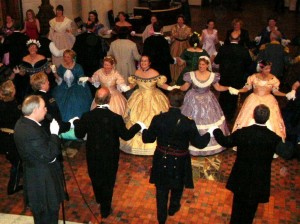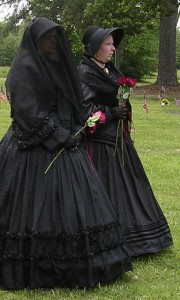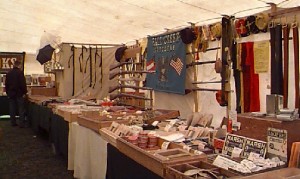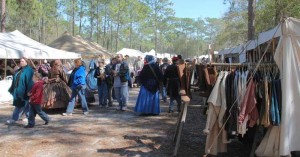People new to Civil War reenacting often find themselves overwhelmed by all of the work required to do it correctly. I’m here to impart my experiences, tips and tricks drawn from 16 years of periodic participation in such reenactments. I’m starting from scratch with the assumption that the reader has never even attended a reenactment as a spectator just to keep everybody on the same page. If you have questions at the end of each blog in this series, please put them in the comments at the bottom. I’ll either use the questions in a Q&A blog at the end or I’ll use them as we progress.
Why People Reenact
Reenacting any period of history is about experiencing what the people at that time did while educating the public. Individual reasons for doing it vary. Some people do it because they’re naturally theatrical and the possibility of acting on a very large stage appeals to them. A great many do it because they have ancestors who fought in the war and they want to know what their blood went through to be here today. Many do it because they simply love exploring history in a tangible way. There are also quite a few active and retired men from our current armed services who reenact the Civil War in their spare time as well. They seem to find comfort in the natural camaraderie that develops among the other reenactors just as it would in their own military service.
And then there are sub-reasons not so talked about like the reasons that got people into it in the first place. They’re more like side affects of the hobby, such as the paranormal. Most reenactors have had experiences with the spirits of Civil War soldiers and other people of that period. They don’t talk about it right away though. It takes time for them to open up about it from what I have seen. Perhaps they’re afraid of ridicule. The amount of reenactors who have had spiritual experiences is astounding, and the experiences are not just limited to the more liberal types. I’ve heard a lot of stories from big, tough, highly reserved and conservative men. There is also a giant elephant on the battlefield, so to speak, of reincarnation, although they’re much less likely to talk about that openly. I’ve heard enough in private from many reenactors to make me realize that there are a lot of soldiers and civilians still fighting out their past lives by reliving them at reenactments.
How a Reenactment Works
The construction of a reenactment is basically the same whether you’re at a small event or a mainstream event (we’ll go over reenactor language soon). They don’t usually take place on the actual battlefields because they are now national parks that cannot be damaged, although there are some that do. Usually someone nearby with a large piece of empty property will rent out their land for the weekend.
The first morning is about reenactors arriving, setting up their camps, and generally preparing for the onslaught of tourists. Once you’re in camp and the vehicles are removed, the majority of reenactors will remain in period clothing and live the period way for the entire weekend whether tourists are watching or not. That is, after all, the only way to do it if you’re really there to live the Civil War. You should have a period correct tent or borrow one or share one, proper blankets, proper cots if necessary, proper storage items such as carpet bags or wooden crates, etc. Anything modern needs to be disguised inside of something period correct. We’ll go over a supply list later. Sometimes tourists assume our camps are just for show and we don’t actually use them, but we do, and the reenactors who go to hotels at night are in the minority. (I call them the Hotel Brigade.) If you question whether you’re tough enough to camp the period way for the entire weekend, let me impart some encouragement on you: I’m a quadriplegic and I sleep on the ground like everybody else. If I can do it, so can you. At the bigger events, you are usually provided with things like firewood, water and some meals. At the small, hardcore events, you’re on your own because people in the 1860s were on their own.
 Tourists start arriving around mid-morning and they wander around the different sutler tents, often set up in what’s called Sutler Row. A sutler is a place that, during the war, soldiers could buy extra food, clothing, supplies, etc. In the reenactment translation, a sutler is where tourists can buy books, movies, souvenirs, and so forth, while reenactors can buy new items for their impression like clothing, jewelry, weaponry, accessories, and so forth. Additionally, there may be activities for tourists to watch, like ladies tea parties (sometimes those are private though), listening to soldiers teach about the war, observing staged surgical procedures in the medical tents, watching companies drill, different lectures sometimes, period music performed by bands, and a number of other scattered activities. It really varies depending on the reenactment. Tourists are always very interested in the camps. If a reenactor has a special skill to demonstrate like sewing or cooking over a fire or anything else, they’ll often stay in camp and demonstrate those things for tourists. If you leave your tent flaps open, expect tourists to look inside (this is why it’s so important to do everything as period correct as possible). They will ask questions about what you’re wearing, what your doing, your belongings, etc., so it’s also very important that you know your history.
Tourists start arriving around mid-morning and they wander around the different sutler tents, often set up in what’s called Sutler Row. A sutler is a place that, during the war, soldiers could buy extra food, clothing, supplies, etc. In the reenactment translation, a sutler is where tourists can buy books, movies, souvenirs, and so forth, while reenactors can buy new items for their impression like clothing, jewelry, weaponry, accessories, and so forth. Additionally, there may be activities for tourists to watch, like ladies tea parties (sometimes those are private though), listening to soldiers teach about the war, observing staged surgical procedures in the medical tents, watching companies drill, different lectures sometimes, period music performed by bands, and a number of other scattered activities. It really varies depending on the reenactment. Tourists are always very interested in the camps. If a reenactor has a special skill to demonstrate like sewing or cooking over a fire or anything else, they’ll often stay in camp and demonstrate those things for tourists. If you leave your tent flaps open, expect tourists to look inside (this is why it’s so important to do everything as period correct as possible). They will ask questions about what you’re wearing, what your doing, your belongings, etc., so it’s also very important that you know your history.
The battles usually take place midday or in the afternoon. Most of the morning, the men will be getting organized, checking their weapons, and doing drills, so women and children are usually on their own. It’s important as a woman to develop your own interest and niche in reenacting because you’re going to be awfully bored if you’re doing it just to follow your husband. The battles begin with the soldiers marching from camp to the field while the tourists pile up at the field barricades to watch. Obviously live ammunition is not allowed but the shots are blanks and still make a lot of noise. Depending on the size of the reenactment, there may be a few cannons or a lot of cannons. Small children or people with anxiety disorders or heart problems may not be good candidates to watch reenactments because of the loudness of cannon fire and the action. The women reenactors usually come along from camp and watch the battle with the tourists. They’ll often answer questions and explain what’s going on as well.
 After the battle is over (they usually last about an hour or two sometimes), many of the tourists will go home. Some will stay for a while and keep walking around. Usually all of the tourists will be gone by 4 or 5 in the afternoon but definitely all are gone by sundown. That’s when the reenactors relax and spend the evening socializing, having supper together, and there is usually a ball on Saturday night. At the ball, women have a better chance at mingling with men. It usually takes place in a very large open tent with a live band playing period music. There will also be a few experts on hand teaching period dances to people that haven’t attended a ball in the past. Reenactors will wear their formal clothes if they have them and the dancing will go on pretty late into the night. For women, the ball is usually the highlight if the weekend.
After the battle is over (they usually last about an hour or two sometimes), many of the tourists will go home. Some will stay for a while and keep walking around. Usually all of the tourists will be gone by 4 or 5 in the afternoon but definitely all are gone by sundown. That’s when the reenactors relax and spend the evening socializing, having supper together, and there is usually a ball on Saturday night. At the ball, women have a better chance at mingling with men. It usually takes place in a very large open tent with a live band playing period music. There will also be a few experts on hand teaching period dances to people that haven’t attended a ball in the past. Reenactors will wear their formal clothes if they have them and the dancing will go on pretty late into the night. For women, the ball is usually the highlight if the weekend.
The last day, people pack up their things, put on their regular clothes, and say their goodbyes. When the weekend was especially good, sometimes it can be as tough as going home from summer camp! Many of the reenactors already know each other from other reenactments or living histories. The reenacting community is rather like a small town, so if you’re a fairly regular participant, people who don’t actually know you will know you by reputation soon enough. And like a small town, the reenacting community also means people will know your business and vice versa. The gossip aspect of it is very much an undercurrent at these things, but that’s true whenever you put the same people together in an isolated location for repeated weekends. The key is to make friends with everyone as best as you can and avoid participating in the gossip. Build a reputation of honor for yourself. It’ll win more respect at the end of the day than knowing everybody’s business. For the most part, reenactors are good people but there will always be a few bad apples in any hobby, sport, school or workplace. It’s the nature of the beast.
Reenactor Vocabulary
The reenacting lifestyle has its own language. If you participate in even one reenactment, you’re going to hear the language, so it’s important to understand it as quickly as possible. I found a list of common terms for you all. Most of these terms apply to soldiers but it’s important for women to understand them as well because you need to be able to communicate with the soldiers. I took an existing list and added a few more terms that I’ve heard passed around over the years. I also added some terms that apply to ladies.
Artillery – The unit that operated the cannon, mortar and heavy weapons.
Ballgown – Formal evening gown for women made of the best materials a woman can afford for her impression. It’s usually off the shoulders and short sleeved.
Battle Reenactment – Scripted battles are reenactment in the strictest sense; the battles are planned out beforehand so that the companies and regiments make the same actions that were taken in the original battles. They are often fought at or near the original battle ground or at a place very similar to the original. These demonstrations vary widely in size from a few hundred fighters to several thousand, as do the arenas used (getting the right balance can often make or break the spectacle for the public).
Bonnet – A head covering for women made of quilted fabric, straw, felt and a variety of decorative things like flowers, fruit, birds, lace, and they tie under the chin with ribbon.
Brogans – low quarter shoes that are period-appropriate for the Civil War, particularly common with enlisted soldiers.
Bummer – A forage hat.
Camp Dress – Very simple dress usually worn without hoops and made of inexpensive fabric that can easily be replaced. Worn for working around camp by fires and worn for impressions of civilian refugees.
Cavalry – A unit that traveled and fought on horseback. The hallmarks of a cavalry unit were speed and mobility.
Character Reenactors – Some reenactors portray a specific officer or person such as General Robert E. Lee, U. S. Grant, President Jefferson Davis or Abraham Lincoln, or a less well known officer such as Col. Abram Fulkerson. Character reenactors may also portray a civilian man, woman, or child of significance. These reenactors often do not participate in the actual combat portion of the reenactment and serve as narrators to the audience during the battle. Often, character reenactors have extensively researched the person they portray and present a first-person narrative of his story.
Chemise – Undergarment worn by women that resembles a nightgown made of white cotton. It’s short sleeved, shapeless and hangs to about mid-calf, worn under the corset, petticoats and hoops.
Civilian – A person who reenacts a non-military impression during reenactments. Many people create extensive civilian impressions to participate in reenactments.
Colors – The flag. This refers to the unit flag, the state flag, the national flag – any flag on the battlefield. A unit’s colors were not only a form of communication but a banner of great pride during the Civil War, one to be defended to the death.
Combat Demonstration – Combat demonstrations are mock battles put on by reenacting organizations and/or private parties primarily to show the public what combat in the period might have been like. Combat demonstrations are only loosely based on actual battles, if at all, and may simply consist of demonstrations of basic tactics and maneuvering techniques.
Commercial Reenactment – Many castles, museums, and other historical tourist attractions employ actors or professional reenactors as part of the experience. These usually address the recreation of a specific town, village, or activity within a certain time frame. Commercial reenactment shows are usually choreographed and follow a script. Some locations have set up permanent authentic displays. By their nature, these are usually living history presentations, rather than tactical or battle reenactment, although some host larger temporary events.
Corset – Female undergarment made of cotton with stiff supports made of whalebone in history and steel boning in the present. The front closes with hooks and eyes while the back is secured with laces. It’s an important piece to the period correct impression and gives the body the correct 1860s silhouette.
C.S. or C.S.A. – Confederate States or Confederate States Army
Day Dress – More decorated and fancy than the camp dress. Worn when women were socializing in the daytime rather than doing housework or camp work.
Dismounted Cavalry – A hybrid of infantry and cavalry. Dismounted Cavalry traveled by horseback but normally fought on foot.
Drill – The unit practicing maneuvers or marching. Typically a unit will drill prior to a reenactment to learn particular moves that will be used in the battle.
Facing the Elephant – The Civil War soldier’s term for going into battle.
Farby – A reenactor’s term for anything not period-appropriate. Reenactors try to avoid “being farby” – some go to great extremes (see the definition of “threadcounter”). As you develop your impression over time you can replace items that are not period-appropriate in your uniform and camping setup. This may include anything from getting period gear for your tent to picking up authentic wire-frame glasses.
Federal – the Northern Army. Also called Union.
Forage Hat – similar to a kepi but taller on the top so that it falls forward to the bill of the cap.
Hoops or Crinoline – Undergarment designed to support the weight of petticoats and a dress to give the 1860s silhouette a bell shape.
Impression – A fictional persona of someone living during the Civil War that has been created by a reenactor. The reenactor then takes the role of the impression. Impressions can be military or civilian.
Infantry – The foot soldiers who marched into battle.
Kepi – The standard hat you think of as a Civil War hat.
Living History – Another name for reenacting. A living history event might include a static display or presentation at a school or community occasion. Living history events are designed to educate the public on a soldier’s life during the Civil War.
Mainstream – Mainstream reenactors make an effort at appearing authentic, but may come out of character in the absence of an audience. Visible stitches are likely to be sewn in a period-correct manner, but hidden stitches and undergarments may not be period-appropriate. Food consumed before an audience is likely to be generally appropriate to the period, but it may not be seasonally and locally appropriate. Modern items are sometimes used “after hours” or in a hidden fashion. The common attitude is to put on a good show, but that accuracy need only go as far as others can see.
Maximum Effort – An event where all members are strongly urged to attend.
 Mourning Dress – Dress typically made of black crepe worn by women in periods immediately following the death of a loved one.
Mourning Dress – Dress typically made of black crepe worn by women in periods immediately following the death of a loved one.
Muster – A gathering, especially of troops, for service, inspection, review or roll call.
National Event – A large event, commemorating an actual battle, normally attended by units nation wide.
Period-Appropriate – If something (clothing, weapons, camping gear, etc.) is in the same form, style and manufacture as it was during the war, it is said to be period-appropriate. Also known as period correct.
Petticoat – Undergarment for women worn like a skirt but it’s made of white cotton. It provides warmth and adds volume to the 1860s bell shaped silhouette. Worn in multiple layers.
Progressive or Hardcore – Sometimes derisively called “stitch counters”, “authenticity nazis” or even “stitch nazis”, many people have misconceptions about hardcore reenactors. Hardcore reenactors generally value thorough research, and sometimes deride mainstream reenactors for perpetuating inaccurate “reenactorisms”. They generally seek an “immersive” reenacting experience, trying to live, as much as possible, as someone of the period might have. This includes eating seasonally and regionally appropriate food, sewing inside seams and undergarments in a period-appropriate manner, and staying in character throughout an event. The desire for an immersive experience often leads hardcore reenactors to smaller events, or to setting up separate camps at larger events.
Reenactor – A person who recreates the War Between the States or Civil War as a soldier.
Tactical Combat – Tactical battles are generally not open to the public. Tactical battles are fought like real battles with both sides coming up with strategies and tactics to beat their opponents. With no script, a basic set of agreed-upon rules (physical boundaries, time limit, victory conditions, etc.), and on-site judges, tactical battles can be considered a form of live action role-playing game, but, in the cases where firearms are used, with real weapons firing blank ammunition (depending on gun control ordinances).
Threadcounter – A reenactor who insists on a historically accurate impression, right down to having a uniform made of the correct fabric, with buttonholes having the same threadcount as those uniforms worn in the 1860s. The opposite of a threadcounter would be “farby” (definition above). Also known as Stitch Nazi, Progressive or Hardcore.
Sack Coat – the standard coat for Civil War soldiers. A simple style of coat that was easy to produce in large quantities.
Shell Jacket – Cut shorter than a sack coat, the shell jacket extends down to the waist. It can be worn buttoned up, completely open or buttoned only at the top.
Slouch Hat – Similar to what many refer to as a cowboy hat, the slouch hat was worn by officers and enlisted alike. Particularly for Union soldiers, the slouch hat would have a colored braid to indicate the type of unit that soldier was with – yellow braid meant cavalry, blue braid meant infantry and red braid meant artillery. This helped commanders identify their troops from long distances.
Sutlers – Merchants who followed troops during the Civil War. Today, modern Sutlers set up tents at reenactments to sell a wide variety of uniform items, clothing, tools, equipment, souvenirs and other Civil War-related items.
Union – the Northern army. Also called Federal.
Continue on to The Lady Civil War Reenactor: Part II now.

















I have been doing the living history/reenacting since 1986. Of everyone I know who has been doing this nearly as long as I have or longer, everyone has a story of a paranormal experience.
How is currency handled at events? What do you wear to bed? How are tents set up? Can you have a fire? How do you get water?
Hey there, I am looking into starting to reenact. I have several male friends who already do this, and they can tell me quite a bit about how most things work, but I think they might be mistaken about certain things having to do with the women folk. One of them has been telling me quite a bit about what I should do when making a ball gown, he says that I need to wear full length gloves that cover my elbows, because it is period correct, however when I look up reenactment photos, or even authentic images of women in their fanciest, they are only wearing write length or forearm length gloves. Also, I am not a married woman, so I would be going into it as a single girl with no husband, is this taboo? Are there women that go as say an heiress who inherited her money before she got married? Or perhaps just a daughter who just happens to not attend these events with her parents? Any and all help would be appreciated!
awww I love this post and the pictures! And wow, your camp was far from the ball! And I’m SO grftaeul we got to meet! I’m blessed to have you as my friend. =) CAN’T WAIT TO SEE YOU!!!!!!!!!!!!
A small group of friends and I are planning to attend the upcoming Battle of Franklin Sesquicentennial reenactment as spectators. How common is it for spectators to attend in period costume, and is this generally encouraged or ridiculed?